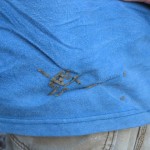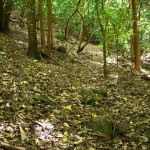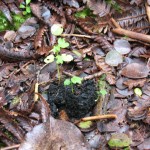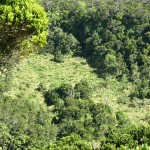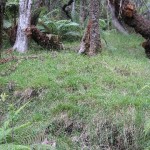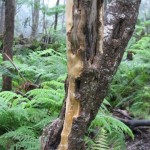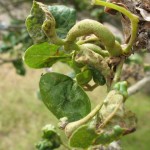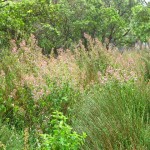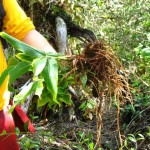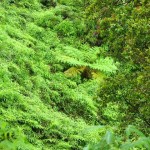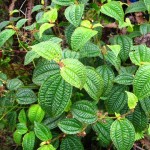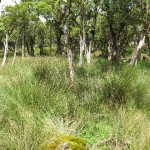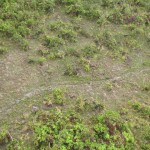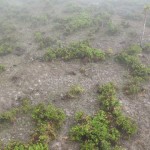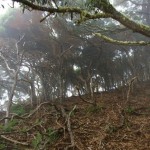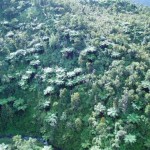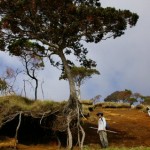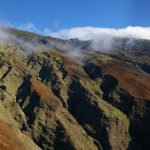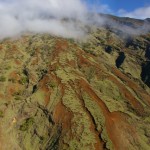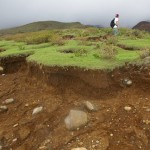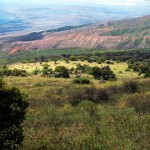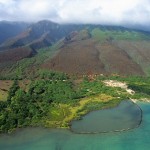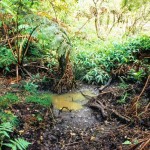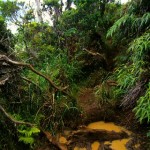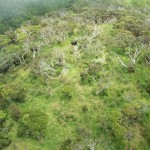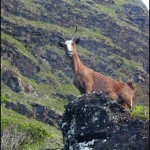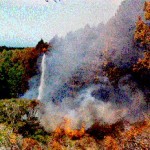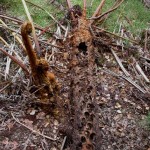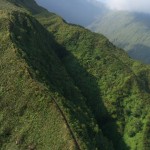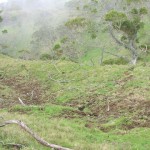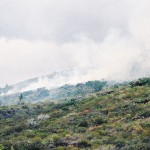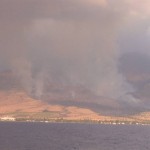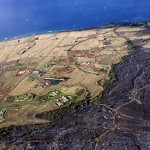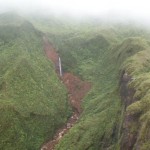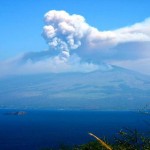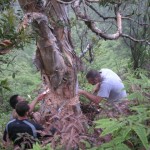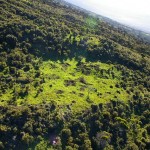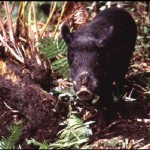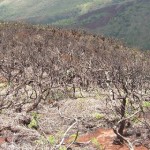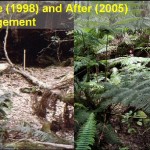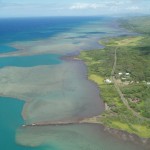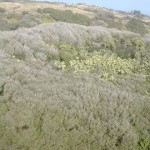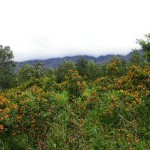Hawaii’s forested watersheds face major threats that degrade its health and negatively impact its ability to provide ecosystem services such as clean and abundant water, native habitats for native species, and socio-economic benefits such as culture, education, and recreation opportunities. Watershed Partnerships are working hard on-the-ground to manage such threats as feral ungulates (hoofed animals such as cattle, goat, pig, deer, and sheep which damage forests by browsing, rooting, and trampling vegetation so the ground is left bare and soils exposed for erosion), invasive weed species (which can take over a native forest and impact its ability to capture waters and hold soils), forest pest and disease, and wildfire.
Click on the images below to see how these threats can impact forested watersheds. You can also view a 2 minute 20 second video about threats facing our watersheds (recommend viewing in full screen for sharper images and remember to turn on the sound).
httpvh://www.youtube.com/watch?v=B_qsAScsoE8
- West Maui: Seeds of invasive plants often get stuck to clothes and shoes and get transported to different areas.
- A priority invasive weed of the Watershed Partnerships, strawberry guava is a major threat to native forested areas.
- Kohala: Feral ungulates can leave droppings, which house seeds of invasive plants such as strawberry guava
- Kauai: Patch of Kahili ginger which has taken over the uluhe and is spreading out to change the structure of the native forest.
- Fountain grass: A priority invasive weed species that is a fuel load for wildfires. Fountain grass is also a fire adapted species so it relies on fire to regenerate and becomes the first to establish and spread after a wildlfire occurs.
- Feral cattle open up the forest understory to create grassy areas in which invasive weed species become established.
- Kau forest: Feral pigs rub up against tree barks and can damage trees, weakening them so they are more susceptible to disease.
- Kau forest: Feral pigs will often dig up and remove native understory vegetation to create bare patches of soil.
- Kohala: Eurythrina gall wasps are a forest pest that endanger the native wiliwili tree species.
- Kohala: Invasive weed species such as those above replace diverse native vegetation and spread out into forests.
- Kauai: Invasive weed species such as Kahili ginger will take over forested areas and weaken forests by destroying the diverse make-up of vegetation that makes up a healthy, functioning forest.
- Kauai: Australian tree fern is a priority invasive weed species that can quickly establish in forested watersheds. One plant can produce millions of spores that are carried on the wind.
- Kohala: Clidemia is a priority invasive weed species.
- Kohala: Areas of bunchgrass are created when feral cattle are present.
- Kohala: Trails by feral pigs open up areas for invasion by invasive weeds which can be carried by feral pigs on their bodies or seeds passed through their droppings.
- Kohala: Feral pigs can open up vegetated areas by digging to create bare areas, which can be a source for erosion in heavy rainfalls.
- Leeward Haleakala: An aalii forest with a destroyed understory by feral ungulates.
- Kauai: An example of how Australian Tree Fern can begin to dominate native vegetated watershed areas.
- Leeward Haleakala: Black dots are feral goats, which have destroyed the vegetation and created large expanses of barren areas.
- Leeward Haleakala: With no forest remaining due to feral cattle and goats, areas in which forest understory are replaced by grass and bare soils do not hold soil as effectively as foret trees with their deep roots, thereby creating huge erosion problems.
- Erosion Kahikinui
- Leeward Haleakala: Huge areas of bare eroded slopes, which were once home to dryland forests, are now soil patches due to feral ungulates.
- Erosion
- Puu Kolekole, “Snail Meadows,” Kamakou Preserve, Molokai
- Molokai: The vegetation on the south slope has been destroyed by feral goats. During heavy rainfalls, the soil is washed down to the coast, where the silt impacts the coral reef.
- Pig wallow, pig damage, Kamakou Preserve, Molokai
- Molokai: The vegetation on the south slope has been destroyed by feral goats. During heavy rainfalls, the soil is washed down to the coast, where the silt impacts the coral reef.
- West Maui: Feral cattle can reach high elevations and enter native forested watersheds. They can open up areas of the forest and bring in invasive plants.
- West Maui, feral goat
- Molokai: Wildfires can not only wipe out forests, but often the first species that return to an area after a fire are invasive plants (which are often fire adapted).
- Hapu fern eaten by a feral pig
- West Maui: Illegal dirt bike trails are a threat to watersheds for many reasons. Not only do dirt bikes destroy native vegetation, they can also introduce invasive weeds into areas as well as cause wildfires.
- Leeward Haleakala, feral pig damage
- Leeward Haleakala, Kanaio fire
- West Maui, Lahaina: Wildfires, if not controlled in forested areas, can quickly become a threat to residential areas.
- Landslide
- Maui, Polipoli and Kula fire
- Oahu: Invasive species such as paperbark threaten the diversity of native forests by quickly becoming established and creating single species forest stands.
- Kohala: Clearing in the forest created by feral pigs.
- Feral pig eating a hapu fern
- Oahu: Post fire scene. Often, invasive weeds are the first to emerge and quickly outcompete native vegetation if they are not controlled for.
- Olaa-Kilauea: Area on the left had been impacted by feral pigs. Management included fencing this over 2,600 acre area and removing the pigs. Understory returned as a result of seeds in the seed bank allowed to grow without pressure from pigs.
- Molokai: Kamalo Coast, after a heavy rain, soils from above the eroded slopes cover the reef.
- East Maui: Ohia rust, a forest disease, works quickly to destroy a rose apple area.
- Leeward Haleakala: Invasive weeds such as silk oak and lantana are a threat to diverse native ecosystems.
